
Exhibition:
Couture Korea (우리의 옷, 한복 )
The Asian Art Museum, San Francisco
November 3, 2017–February 4, 2018
Catalogue:
Couture Korea
Edited by Hyonjeong Kim Han
San Francisco: Asian Art Museum, Seoul: Arumjigi Culture Keepers Foundation, 2017.
106 pp.
Paper $19.95
ISBN 9780939117826
In the exhibition Global Fashion Capitals held at the museum of the Fashion Institute of Technology (FIT) in New York City in 2015, Seoul was positioned as one of the sixteen emerging new fashion cities.1 Sophisticated Korean contemporary styles have cropped up in various places through the global spread of Korean popular culture and performing arts since the turn of the twenty-first century. The country’s rich sartorial heritage, however, has not received much treatment by either global academia or public exhibitions. It is thus timely that the Asian Art Museum of San Francisco, as the leading institution of Korean art in the United States, has taken the initiative. It is fitting that the first American museum with an independent department of Korean art is home to this historic event: the first major exhibition that explores the past, present, and future of Korean fashion culture from a truly global perspective. The curatorial staff, including Hyonjeong Kim Han, the associate curator for Korean art, collaborated with the Arumjigi Culture Keepers Foundation in Korea2 and Chanel Heritage. Over 120 works are encased behind glass in the Osher, Hambrecht, and Lee galleries. The thematic trajectory through the galleries stresses cultural continuity, from the formations of the authentic aesthetic of Korean clothing to its various reinterpretations.
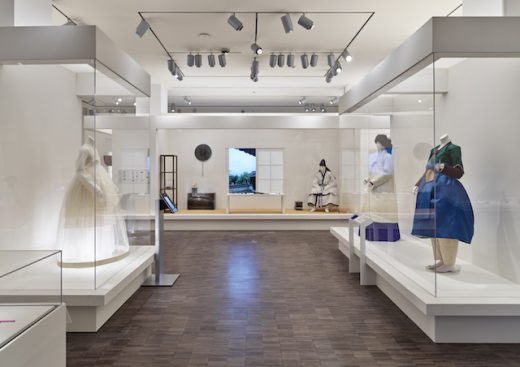
The exhibition begins in the Osher gallery with the question: “What is hanbok?” Leveraging aesthetics and cultural history, upper-class men’s, women’s and children’s dress from the Joseon dynasty (1392–1910) are displayed to reveal “subtlety and restraint”3 through the social and cultural norms imbued in the designs. The space is accordingly set into “the three main volumes to echo the traditional three-house domestic compound, reflecting its open-ended nature.”4 Surviving Korean historical garments fall into three categories: 1) votive offerings from Buddhist statues, 2) hereditary artifacts passed down within royal and aristocratic families, and 3) items from tomb excavations, including the shrouds and extra garments that were placed within coffins and attest to the clothing used by the deceased or family members. The garments displayed in the Osher gallery are either contemporary reproductions of such extant historical garments or recreations based on representations from the period, such as genre paintings and portraits.
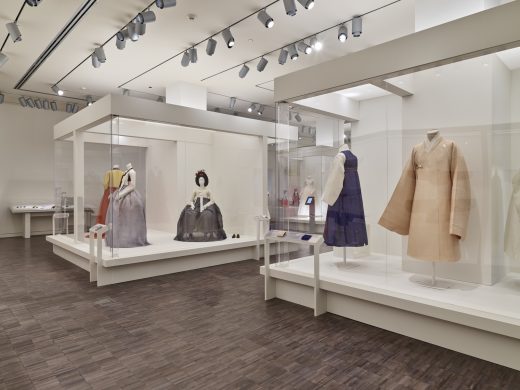
The first object that greets visitors is a reproduction of a gossamer coat of King Yeongjo (r. 1724–1776) (Cat. 1). The original coat was retrieved from the interior of the Guanyin Buddhist statue in the course of renovations at the Pagye Temple in 1997. Along with the fascinating story behind the discovery, the visual effect of the layers of planes and impeccable seam lines of the diaphanous fabric hooks visitors at first sight. A series of vests are displayed around the coat, suggesting their adaptability to a modern look: a few lengthy dap’ho, a bangnyeong with square neckbands, several baeja with sashes and length discrepancies between front and back, a jokki with pockets, and a cheollik with rows of horizontal cords at the waist and gathers below. In the display modeled after Confucian scholars’ quarters, the robe, sim’ui (Cat. 19), allows viewers to explore how notions of cosmology and social norms were concretely embodied in clothing design. The four panels above the waist signify the four seasons, the twelve panels hanging down from the waistline symbolize the twelve months, and the black edge-bindings manifest the wearer’s filial piety. By wearing sim’ui, Confucian scholars embraced their cosmology and paid respect to their parents. The wedding ensembles, the babies’ one-year-old celebration clothing (Cats. 4 and 5), and the coming-of-age ceremonial ensemble are replete with embellishments embodying aspirations for longevity, conjugal affection, fecundity, prosperity, nobility, and fortune. No motif—whether embroidered, gold-stamped, or woven into damask—was applied without a symbolic meaning that was understood and valued at the time. The elaborate work of the hand-quilted newborn’s clothing and one-hundred-day celebration dresses denote the unconditional love of the mothers who painstakingly made them. Such a normative approach to clothing design is distinct from the aesthetic emphasis in western traditions. While the men’s ensembles (jeonbok over durumagi, jungchimak, and chang’ui) showcase the natty and decorous styles that reflect the spiritual ideals pursued by Joseon men, the women’s ensembles representing the styles of the sixteenth, eighteenth, and nineteenth centuries raise visitors’ aesthetic curiosity as to what lay behind their progression. During this time, Joseon society was immersed in political, ideological, and socioeconomic transformation and experienced significant collective competition in regards to dress styles. The overall generously sized styles evolved into one showing remarkable contradistinction between an extremely form-fitting cropped top and a bouffant, elongated skirt. The trend of such exaggerated and ostentatious clothing reached a culmination around the turn of the twentieth century, when the style began to gradually revert to a compromised silhouette resulting in the archetype of the modern hanbok. The museum labels could have provided more information about the dynamism of the social backdrop. Additionally, the show could have featured a greater volume of items that reached similar stylistic extremes in this period, such as a gache (ornamental wig), a norigae (jeweled pendant), and a paeyeong (man’s hat tie). However, a full set of undergarments (Cat. 17) is a well-chosen and essential inclusion. The mannequin in full undergarments is lit from below to illuminate the successive layers. An interactive touch screen shows the order in which each item was put on. This installation quenches visitors’ curiosity about how the dimensionality of the silhouette shown in the eighteenth- and nineteenth-century ensembles was achieved, even by anti-structural Korean dress construction.
The aesthetic epitome of hanbok, however, is better perceived by the wearers’ demure deportment and graceful body movements. The four-channel mega screen set in the North Court, the hallway between the Osher and Hambrecht galleries, compensates for the static view presented by T-hangers and dressed mannequins in the galleries. Watching the ordered donning of hanbok or an exquisitely slow dance performance, the viewer can revel in the layered transparency of the textiles and the softly flowing lines and silhouettes created by the dancers’ movements. The videos also display hanbok’s complexity of forms, multiplicity of color palettes, unique silhouettes, varied materials, and immaculate seaming details. In another corner of the hall, two small screens provide complementary accounts that further elucidate Couture Korea. One demonstrates the intensive process involved in recreating historically accurate garments like gu’ui, a leather coat, and yoseon cheollik, a ramie robe with tucks and gathers at the waist, validating the exhibit’s title by revealing the couture craftsmanship. The other small screen showcases contemporary designers via an interview with Teok Jin and collection excerpts from Seonoc Im and Misun Jung.
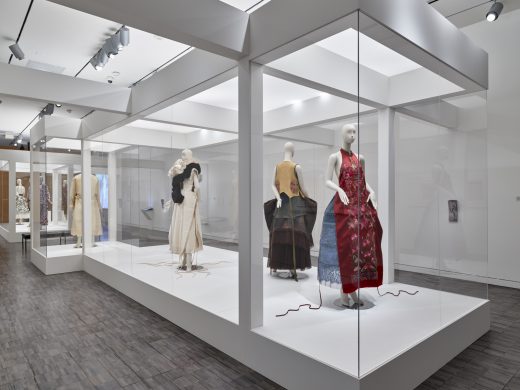
With the time frame of 1995–2016, the Hambrecht gallery’s theme of “Between East and West” sheds light on two established designers: Teok Jin (b. 1934) based in Seoul and Karl Lagerfeld (b. 1938) based in Paris. Each displayed creation is juxtaposed with a corresponding cultural referent, while enthralling runway films with sound are projected to exhilarate visitors. The temporal gap between the Osher and Hambrecht galleries accounts for the social context of westernization and modernization in twentieth-century Korea. Korea’s long sartorial tradition, which crystallized into its own unique style during the seventeenth through nineteenth centuries, as displayed in the Osher gallery, was repudiated in daily practice by a surge of top-down diffusion of westernization in the twentieth century. The laborious handwork necessary for traditional clothing began to be replaced by mechanization. Around that time, the term “hanbok” was coined to differentiate between traditional Korean clothing and its counterpart, “yangbok,” western clothing. While yangbok became the social norm, hanbok was gradually relegated to special ceremonial occasions and labeled as “national dress,” used to manifest the nation’s cultural identity. The western apparel manufacturing industry started in small-scale boutiques, then adapted to mass production of ready-to-wear clothing and made a significant contribution to the nation’s export shares. While this was in process, Koreans put aside their long traditions to absorb, digest, and master the new fashion and catch up with the rest of the modern world.
In the early 1990s, Korean designers made inroads into global modern couture in Tokyo and Paris. At that point, the designers felt a need to showcase authentically Korean styles on the international stage, so they all looked to the country’s traditions. Teok Jin, the most venerable among the group of designers that included Shinu Lee (b. 1941), Mihwa Hong (b. 1955), Younghee Lee (b. 1936), and Sangbong Lie (b. 1955), to name a few, is honored at Couture Korea. Jin’s implicit principle of incorporating a traditional aesthetic into her western clothing design eschews a direct and visceral presentation of inspiration. Rather she strives to embody its underlying mentality. She draws on the idea of the seonbi spirit, a doctrine of ideal virtue that Joseon scholars pursued through life-long discipline. The seonbi spirit upheld consistency between learning and practice, loyalty, steadfastness in principles, and the resistance of corruption. For example, Jin translated the purity of seonbi spirit that was visualized by a light blue solid-color durumagi (a coat for scholar) into a modern trench coat using naturally dyed translucent silk organza (Cat. 12). Her work exceeds mere composition by creating a symbiotic and compatible relationship between two contrasting concepts, such as binary elements from East and West. Examples include two ensembles from the blood series (1995): a look that pairs a planar front panel with a crinoline cage (Cat. 11) and one that coordinates a vest made out of an embroidered royal wedding gown with deconstructed denim jeans that once belonged to laborers. Another object, a dress with a pleated train, unconventionally combines fabrics: rough peasant hemp for the outer fabric with a lining of royal patterned silk gauze (Cat. 13). In her works, thin strips of fabric frequently drape down onto the floor (Cat. 11). They are like tokens of attachment to the works, lingering even after completion and symbolizing her reluctance to let them go, as though calling out, “you will be missed.”5
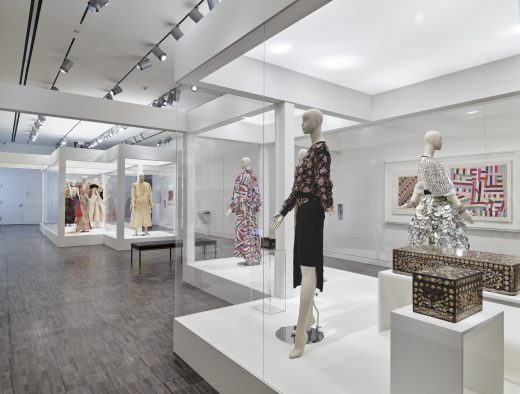
Lagerfeld held his Chanel 2016 Cruise collection, the brand’s commercial driving force, in Seoul upon recognition of the rapid spread of Korean pop culture into the world and the importance of Seoul as an emerging fashion capital. The collection’s Korean context, reinforced by the brand’s international acclaim, resonated broadly: part of the collection was featured at the exhibition Korea Now, held at Musée des Arts Décoratifs, Paris (2015–2016), as well as in the movie Okja (2017) and at Couture Korea (2017–2018). Global inspiration in western designers’ collections has become prevalent as the fashion business has expanded its global scope. In such conflated fashion expressions, “an aesthetic of surfaces rather than an essence governed by cultural contextualization”6 has prevailed, as was demonstrated in the exhibition China: Through the Looking Glass. Similarly, in the Couture Korea exhibition, four works selected from the Chanel 2016 cruise collection are juxtaposed with the Korean referents from which they derived patterns and motifs (chosen from the museum’s ample collections of patchwork textiles and mother-of-pearl lacquerware).
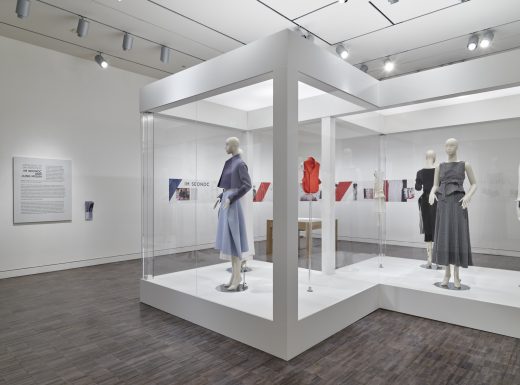
Lastly, the Lee gallery’s display, subtitled “From Seoul to San Francisco,” addresses the design process of two younger Seoul-based emerging designers, Seonok Im (b. 1962) and Miseon Jung (b. 1984), and how they embody a new, fashion-forward era by studying the past. Both designers pivot toward unconventional materials: neoprene by Seonok Im and knit by Misun Jung. Im’s neoprene dresses not only adopt forms from extant period garments (Cats. 22, 23), but also hold the imagery of hanbok in their physicality. The smooth and sleek surface of neoprene matches with the soigné image of hanbok, especially in terms of the broad negative space in the design, while its resilience and clean seaming technique assign a prim and proper nuance to the dresses. Jung, working with popular western clothing materials such as knit jersey, wool, and cotton, instills the core aesthetics of femininity she has identified throughout Joseon women’s styles into modern sophisticated clothing, while at the same time imparting practicality and informality. The two designers’ branding mirrors the Korean young generation’s voluntary embrace of their tradition. The emergence of “Koreanness” in Korean daily fashion in the 1990s stimulated a cult of self in fashion, and the “self-orientalizing”7 or “self-exoticizing”8 trend has gained momentum. Young Korean designers have learned the value of cultivating their own cultural resources and have discovered the limitless adaptability of hanbok. To them, hanbok has moved beyond the label of national or traditional dress; it is a fashion statement disseminating the desire to foster cultural pride.
Suzy Menkes, a journalist and fashion critic, commented in Vogue UK on the current exhibit: “Couture Korea proves that in the often choked-up calendar of museum fashion exhibitions, there are still fascinating new subjects to explore that are fresh and full of feeling.”9 Underscoring the rich cultural contexts of hanbok’s unique styles from the Joseon dynasty to the twenty-first century, Couture Korea stands as a visionary inception for the forthcoming curatorship of Korean fashion and beyond. Arguably the show ignited public interest and raised awareness of Korean sartorial aesthetics and will continue to resonate widely in today’s interconnected fashion hybridity. Above all, it will provide an impetus for burgeoning scholarship on the Korean fashion history to thrive within global academic discourse. As attested by the show, the discursive transformation and diffusion of styles in the late Joseon dynasty can challenge the conventional Orientalist definition of fashion as an exclusively western phenomenon. The unearthed garments associated with unique neo-Confucian burial practices and the retrievals of votive offerings from Buddhist sculptures entail stories that resonate with global audiences. Through an in-depth understanding of cultural and historical contexts, the representation of ethnic aesthetics in global fashion may transcend the “aesthetic of surfaces.”
Minjee Kim studied and lectured on Korean fashion history at Seoul National University. She is currently an independent fashion historian and instructor based in the San Francisco Bay Area.
- 1. http://www.fitnyc.edu/museum/exhibitions/global-fashion-capitals.php (accessed February 14, 2018).
- 2. As a non-profit organization, the Arumjigi Culture Keepers Foundation foundation is dedicated to preserving the essence of cultural traditions and reinventing them to serve evolving lifestyles. The following former exhibitions held at the gallery in Seoul contributed to the selection of the objects:, Baeja, the Beauty of Korea (2011); Po, the Seonbi Spirit in Clothing (2013); and Jeogori, and Stories about Materials (2016).
- 3. The question was raised by the curator, Han. Tony Bravo, “Korean fashion to gets [sic] its close-up at Asian Art Museum,” San Francisco Chronicle, October 26, 2017, https://www.sfchronicle.com/style/article/Korean-fashion-to-gets-its-close-up-at-Asian-Art-12309772.php (accessed February 14, 2018).
- 4. Marco Centin, “A Web of Relationships,” Asian Art Museum Members Magazine 7, no. 3 (Fall 2017), 7.
- 5. Jin’s design methodology and inspiration were discussed at the conference, “Jin Teok: Pioneer of Korean Fashion,” held at the Asian Art Museum of San Francisco on November 4, 2017.
- 6. Andrew Bolton, “Toward an Aesthetic of Surfaces,” in China: Through the Looking Glass, exhibition catalog (New York: Metropolitan Museum of Art, 2015), 19.
- 7. Sandra Niessen, Ann Marie Leshkowich, and Carla Jones, eds. Re-Orienting Fashion: The Globalization of Asian Dress, (Oxford and New York: Berg, 2003), 28.
- 8. Ibid., 216.
- 9. Suzy Menkes, “Couture Korea: From Far East to West Coast,” Vogue UK, November 27, 2017, http://www.vogue.co.uk/article/suzy-menkes-couture-korea-from-far-east-to-west-coast (accessed February 14, 2018).
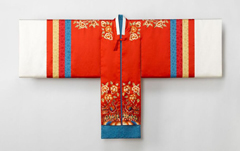
Bridal robe (hwarot), 2015. Reconstruction based on a Josean dynasty garment. Silk. (Photograph © Arumjigi Culture Keepers Foundation)
